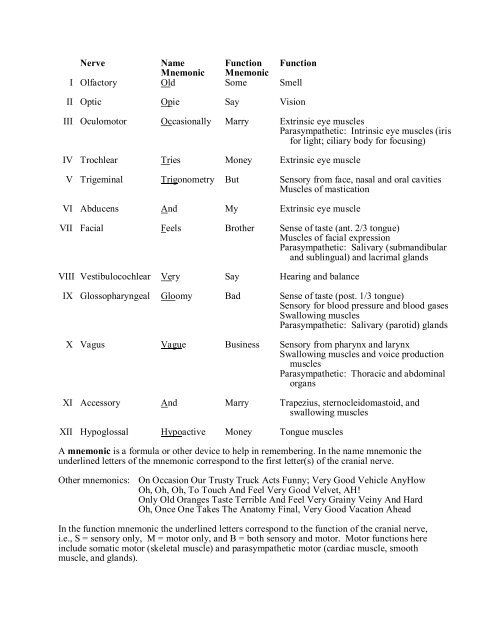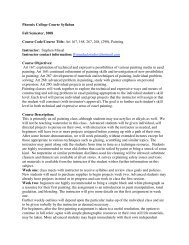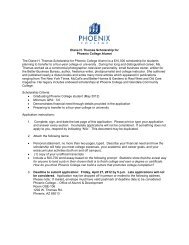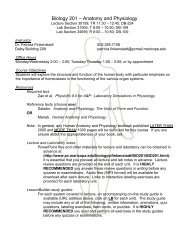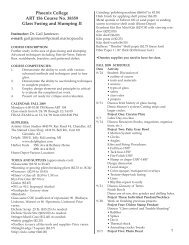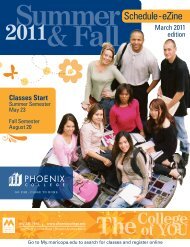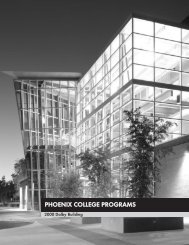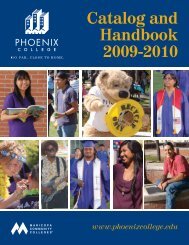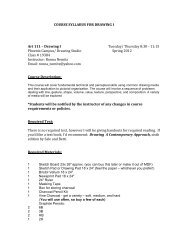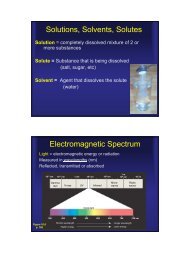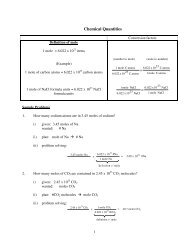Nerve Name Mnemonic Function Mnemonic Function I Olfactory Old ...
Nerve Name Mnemonic Function Mnemonic Function I Olfactory Old ...
Nerve Name Mnemonic Function Mnemonic Function I Olfactory Old ...
Create successful ePaper yourself
Turn your PDF publications into a flip-book with our unique Google optimized e-Paper software.
<strong>Nerve</strong> <strong>Name</strong> <strong>Function</strong> <strong>Function</strong><br />
<strong>Mnemonic</strong> <strong>Mnemonic</strong><br />
I <strong>Olfactory</strong> <strong>Old</strong> Some Smell<br />
II Optic Opie Say Vision<br />
III Oculomotor Occasionally Marry Extrinsic eye muscles<br />
Parasympathetic: Intrinsic eye muscles (iris<br />
for light; ciliary body for focusing)<br />
IV Trochlear Tries Money Extrinsic eye muscle<br />
V Trigeminal Trigonometry But Sensory from face, nasal and oral cavities<br />
Muscles of mastication<br />
VI Abducens And My Extrinsic eye muscle<br />
VII Facial Feels Brother Sense of taste (ant. 2/3 tongue)<br />
Muscles of facial expression<br />
Parasympathetic: Salivary (submandibular<br />
and sublingual) and lacrimal glands<br />
VIII Vestibulocochlear Very Say Hearing and balance<br />
IX Glossopharyngeal Gloomy Bad Sense of taste (post. 1/3 tongue)<br />
Sensory for blood pressure and blood gases<br />
Swallowing muscles<br />
Parasympathetic: Salivary (parotid) glands<br />
X Vagus Vague Business Sensory from pharynx and larynx<br />
Swallowing muscles and voice production<br />
muscles<br />
Parasympathetic: Thoracic and abdominal<br />
organs<br />
XI Accessory And Marry Trapezius, sternocleidomastoid, and<br />
swallowing muscles<br />
XII Hypoglossal Hypoactive Money Tongue muscles<br />
A mnemonic is a formula or other device to help in remembering. In the name mnemonic the<br />
underlined letters of the mnemonic correspond to the first letter(s) of the cranial nerve.<br />
Other mnemonics: On Occasion Our Trusty Truck Acts Funny; Very Good Vehicle AnyHow<br />
Oh, Oh, Oh, To Touch And Feel Very Good Velvet, AH!<br />
Only <strong>Old</strong> Oranges Taste Terrible And Feel Very Grainy Veiny And Hard<br />
Oh, Once One Takes The Anatomy Final, Very Good Vacation Ahead<br />
In the function mnemonic the underlined letters correspond to the function of the cranial nerve,<br />
i.e., S = sensory only, M = motor only, and B = both sensory and motor. Motor functions here<br />
include somatic motor (skeletal muscle) and parasympathetic motor (cardiac muscle, smooth<br />
muscle, and glands).
Brainstem death can be determined by the absence of certain brainstem reflexes. [see Gray’s<br />
Anatomy 38 th edition, p. 1011.]<br />
Normal Reflexes that are<br />
Absent in Brainstem Death<br />
Pupillary reflex<br />
Pupils constrict in response<br />
to light<br />
Oculocephalic reflex<br />
Move head swiftly to one<br />
side; the eyes move in the<br />
opposite direction (doll's<br />
eyes)<br />
Vestibulo-ocular reflex<br />
Put ice-cold water in the<br />
ear; eyes move toward<br />
opposite ear<br />
Corneal reflex<br />
Touch cornea; blink<br />
Grimace (pain) reflex<br />
Response to pain stimuli on<br />
supraorbital ridge or<br />
fingernail<br />
Cough and gag reflexes<br />
Cough: stimulate trachea<br />
with endotracheal tube<br />
Gag: stimulate pharynx<br />
Absence of spontaneous<br />
breathing<br />
<strong>Nerve</strong>s Involved<br />
S: Optic (II)<br />
M: Oculomotor (III)<br />
S: Vestibulocochlear (VIII)<br />
M: Oculomotor (III)<br />
Abducens (VI)<br />
S: Vestibulocochlear (VIII)<br />
M: Oculomotor (III)<br />
Abducens (VI)<br />
S: Trigeminal (V)<br />
M: Facial (VII)<br />
S: Trigeminal (V)<br />
Spinal cord<br />
M: Facial (VII)<br />
S: Glossopharyngeal (IX)<br />
Vagus (X)<br />
M: Glossopharyngeal (IX)<br />
Vagus (X)<br />
Phrenic to diaphragm<br />
S: Glossopharyngeal (IX)<br />
Vagus (X)<br />
M: Phrenic to diaphragm<br />
Location of Brainstem Nuclei<br />
Midbrain<br />
Midbrain<br />
Pons<br />
Pons<br />
Midbrain<br />
Pons<br />
Pons<br />
Midbrain<br />
Pons<br />
Pons<br />
Pons<br />
Pons<br />
Medulla oblongata<br />
Medulla oblongata<br />
Medulla oblongata<br />
Medulla oblongata<br />
Medulla oblongata<br />
Also cough and gag centers in<br />
medulla oblongata<br />
Medulla oblongata<br />
Medulla oblongata<br />
Medulla oblongata<br />
Also respiratory center in<br />
medulla oblongata<br />
S = Sensory input<br />
M = Motor output<br />
[Remember that cranial nerve sensory and motor nuclei can be connected through reticular<br />
formation nuclei. So lack of reflex activity can indicate that several different part of the<br />
brainstem are not functioning.]<br />
Basic premises:<br />
1. The brainstem has many nuclei. i.e., sensory cranial nuclei, motor cranial nuclei, and<br />
reticular formation nuclei.<br />
2. The presence of a reflex indicates sensory input reaches nuclei (reflex centers), the nuclei are<br />
functioning properly, and output from the nuclei reaches effectors. The absence of a reflex is<br />
taken to indicate damage to the nuclei.<br />
3. Several different reflexes are tested at each level of the brainstem. If all of them are<br />
nonresponsive, it indicates the brainstem is nonfunctional.


